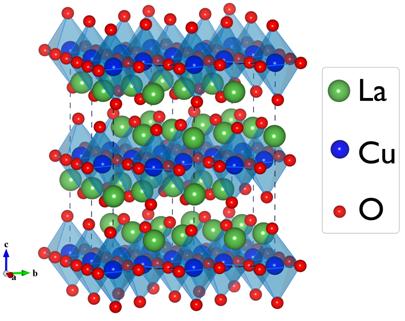| Synchrotron helps unveiling the mechanism underlying thermoelectricity of La2CuO4 ceramics |
| From: PublishDate:2012-06-25 Hits: |
As one of the key materials for national strategic development for energy resources, thermoelectric (TE) materials are renewable energy-related materials based upon either thermo-voltaic (Seebeck) effect or electro-refrigeration (Peltier) effect. TE-devices made with thermoelectric materials have been applied as essential elements in many cutting-edge technologies (e.g. space shuttles, scientific instruments). It was suggested that the TE-devices should be ubiquitously invested in market and readily applied in civil lives if their efficiency can achieve the Carnot efficiency of 30%. On one side thermoelectric materials with high performance can be used to generate power with waste heat (from factories, automobiles, human activities, etc); one the other side the solid state thermoelectric materials are environment-friendly and will not cause secondary pollutions. Henceforward, thermoelectric materials researches are becoming one of the hottest areas for materials scientists in 21st century. Solid-state thermoelectric oxides belong to a family of novel thermoelectric materials. They features in relatively higher thermopower (Seebeck coefficient) and easier manipulation of transport property of charge-carriers simply by tuning the ingredients and site occupation for specific atomic sites. As a good antiferromagnetic insulator, La2CuO4 is known to exhibit superconductivity as the lanthanum site being substituted with alien atoms, e.g. Strontium. Besides, this family of materials possess d9 electronic configuration for copper ions, which renders it as a three dimensional Mott insulator. The German physicist J. Georg Bednorz and Swiss physicist K. Alexander Müller from IBM Zurich Research Laboratory were awarded Nobel Prize in physics in 1987 for their contribution in the discovery of superconductivity in ceramic materials (e.g. La2CuO4). The transport property (e.g. superconductivity) in those materials with copper oxide layer had been the hottest area in condensed matter physics. The Professor Ce-Wen Nan and Professor Yuan-Hua Lin’s group from Tsinghua-university discovered that the pure and lanthanum-site-rare-earth doped La2CuO4 ceramics exhibit excellent thermoelectric performances and are promising candidate for thermoelectric applications at high temperatures. By using the X-ray absorption spectroscopy provided by 4W1B endstation of Beijing Synchrotron Radiation facility (BSRF), they in collaboration with staffs of BSRF studied the local structure of copper-site doped La2CuO4. Combining the macroscopic measured transport properties such as electrical conductivity, Seebeck coefficient, etc, it is revealed that copper-site doping affects the transportation of charge carriers thus rendering increment of electrical resistivity. Moreover, the small-polaron conduction mechanism is adopted to illustrate the metal-to-insulator transition with increasing temperature. Fig.1 Schematic view of the crystal structure of La2CuO4 This work provides interpretation of high temperature transport property of La2CuO4, the parent for high temperature superconductors; and addresses the origin of the doping-induced-conduction-transition at atomic scale. In addition, the application of X-ray absorption fine structure spectroscopy is expanded to the functional materials, providing guidance for improving thermoelectric performances and optimizing technical route. Meanwhile, the merits of synchrotron-based spectroscopy have been demonstrated. Article: W. Xu, Y. Liu, D. Chen, Y.-H. Lin, Z. Wu, Y. Xie, B.-P. Zhang, B. Cheng, C.-W. Nan, and Z. Wu.High Temperature Transport Property of Copper site Doped La2CuO4. Journal of the American Ceramic Society. 2011, 94 (5):1471-1476. |
|
|
| Chinese
Science Highlights
Home /
Copyright © 2011 - 2012 Beijing Synchrotron Radiation Facility


